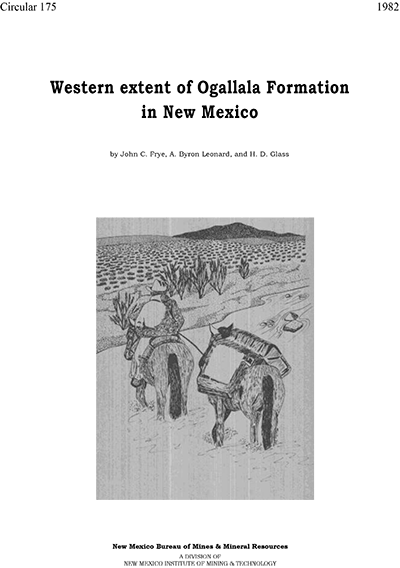
Circular 175—Western extent of Ogallala Formation in New Mexico
By J. C. Frye, A. B. Leonard, and H. D. Glass, 1982, 41 pp., 4 tables, 10 figs., 1 appendix.

This study defines the western limits of the Ogallala Formation (upper Tertiary) west of the Pecos River and documents the late Cenozoic geology of the region, including fragmentary deposits of early Pleistocene age and molluscan faunas of Wisconsinan and Holocene age. Included is an appendix containing clay-mineral analyses and measured stratigraphic sections. The Ogallala was deposited during the latest Tertiary episode of alluvial deposition throughout the Great Plains, where this formation has been documented extensively. However, the Ogallala has not been previously traced to its primary sediment source in the Rocky Mountain belt. Streams feeding the extensive Great Plains alluvial blanket of Ogallala sediments headed in the mountain belt and flowed east and southeast, but identification of these streams and their sediments is obscured in northern New Mexico by extensive volcanic activity. Farther north in Colorado, the extensive erosional belt of the Colorado piedmont has removed evidence of late Tertiary history. Therefore, central and southern New Mexico are the only regions where tracing of headwater sources is possible. This unique situation is largely the result of the late- and post-Ogallala structural history of the region. Extensive warping of the uppermost Tertiary surface that occurred farther north.
A reconnaissance study of the late Cenozoic geology of eastern New Mexico was undertaken during the summer of 1971. Since then, this program was continued through 1979 with two to three weeks of field work each summer. Results of this work have been presented in a series of regional and topical short reports. The program was started on the High Plains of extreme eastern New Mexico and dealt with the stratigraphy of the Ogallala Formation and associated Pleistocene and Holocene basin fills, terrace deposits, molluscan faunas, and clay-mineral compositions. The study initially was concerned with the westward correlation of units described earlier in west Texas. As the field work proceeded westward to include the valley of the Pecos River, it became clear that large areas are underlain by the Ogallala Formation west of the Pecos Valley but that the westward extent of the formation had not been defined. The irregular belt of mountains between the Rio Grande and Pecos River drainages was a major sediment source for the generally easterly flowing streams that carried and deposited sediments of the Ogallala Formation. Delineation of the western extent of the Ogallala and location of through-flowing drainages are of considerable significance to the understanding of the late Tertiary history of the region. Another aspect of this understanding involves the Pliocene-Pleistocene structural warping of the region east of the mountain belt. Because the Ogallala sediments were deposited on a generally easterly sloping surface, identification of stratigraphic units in conjunction with present elevations aids in determining structural warping that occurred in post-Ogallala time. In order to understand the stratigraphy, the sparse Pleistocene and Holocene deposits of the region also were studied to determine approximate dates from their molluscan faunas.
$8.00
Buy
Now
Also available as a free download.
Download
| File Name | Size | Last Modified |
|---|---|---|
| Circular-175.pdf | 2.86 MB | 01/11/2021 03:38:58 PM |



